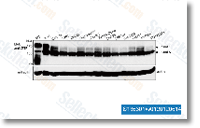Interestingly, probably the most populated professional files are constant with ZGA linked behaviours. For example, the clusters Pilot dsss, Lu dsDssH and Lu dsDdsH correspond to maternal mRNAs degraded throughout the slow phase of cellularisation, whereas the cluster Pilot udss regroups genes show ing a transient activation in the course of cellularisation. A list of cluster biological interpretations is provided in Table one. Strikingly, no gene showed transient activation or repression dependant upon the NC ratio. Grouping of co expression clusters primarily based on discovered motifs Also on the 34 clusters obtained from the dis crete transition profiles described in earlier part, we included 6 clusters selleck resulting from the prior published research, 5 clusters containing maternal and/or zygotic genes defined by De Renzis and co staff, and one cluster containing genes activated dependently within the NC ratio, defined by Lu and co workers.
So that you can detect the full report similarities between clusters have ing the exact same kind of genes and to regroup just about the most pertinent genes for ZGA regulation examination, we carried out a prelimi nary discovery of above represented heptanucleotides from the regulatory areas related with each and every of the 40 clusters. Motif discovery was performed individually in upstream non coding sequences, introns, 5UTR and 3UTR so as to cover many sorts of regulation. The resulting motifs are combined inside a matrix containing significance of under and in excess of representation of every seven letters word in each cluster. Right here, the significance is defined as minus the logarithm with the E worth. We applied hierarchical clustering about the columns of this matrix, so that you can regroup co expression clusters displaying comparable predicted regulatory motifs.
This motif based mostly clustering revealed three forms of clusters, zygotic clusters made from genes activated at early phases of ZGA, maternal clusters containing genes  whose mRNAs is degraded for the duration of early or late cellulari sation, maternal zygotic clusters containing genes transcribed for the duration of oogenesis as well as for the duration of ZGA. This motif based mostly grouping is constant together with the overlap concerning clusters when it comes to gene composition. The resulting classification tree demonstrates that the clusters containing only zygotically activated genes appear to have a coherent regulation because they clus ter tightly, whereas maternal zygotic clusters reveal a additional complicated pattern of regulation. Indeed, some motifs over represented in initial introns and 5UTR of maternal zygotic clusters may also be above represented in upstream sequences of zygotic clusters, whereas the motifs discovered in upstream regions of your maternal zygotic clusters are also identified in upstream sequences of maternal clusters. In addition, clusters containing genes acti vated throughout late cellularisation showed none or number of motifs and are present at unresolved branches of the hierarchical tree.
whose mRNAs is degraded for the duration of early or late cellulari sation, maternal zygotic clusters containing genes transcribed for the duration of oogenesis as well as for the duration of ZGA. This motif based mostly grouping is constant together with the overlap concerning clusters when it comes to gene composition. The resulting classification tree demonstrates that the clusters containing only zygotically activated genes appear to have a coherent regulation because they clus ter tightly, whereas maternal zygotic clusters reveal a additional complicated pattern of regulation. Indeed, some motifs over represented in initial introns and 5UTR of maternal zygotic clusters may also be above represented in upstream sequences of zygotic clusters, whereas the motifs discovered in upstream regions of your maternal zygotic clusters are also identified in upstream sequences of maternal clusters. In addition, clusters containing genes acti vated throughout late cellularisation showed none or number of motifs and are present at unresolved branches of the hierarchical tree.
Hiv Protease Signal
Each virion comprises a viral envelope and associated matrix enclosing a capsid.
